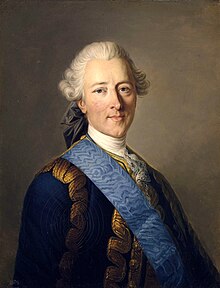Charles-Juste de Beauvau
Charles-Juste de Beauvau , 2nd prince de Beauvau (since 1754) and prince de Craon , (born September 10, 1720 in Lunéville , † May 21, 1793 in Saint-Germain-en-Laye ) was a marshal of France .
Life
Charles Juste de Beauvau was the son of Marc de Beauvau (1679–1754), 1st prince de Beauvau, and Anne Marguerite de Ligniville (1686–1772), comtesse du Saint-Empire, maid of honor to the Duchess of Lorraine and mistress of the Duke Leopold of Lorraine . His sister was Madame de Boufflers , mistress of Stanislaus I. Leszczyński , titular Duke of Lorraine.
His first marriage was on April 3, 1745, Marie Sophie Charlotte de La Tour d'Auvergne (1729–1763), daughter of Emmanuel Théodose de La Tour d'Auvergne, duc de Bouillon . They had a daughter: Louise- Anne-Marie (1750–1834) ∞ Philippe Louis de Noailles, vicomte de Lautrec.
Widowed in 1763, he married Marie-Charlotte-Sylvie de Rohan-Chabot (1729-1807) in March 1764. This marriage left no offspring.
Military career
He entered military service on December 10, 1738, as a lieutenant in the cavalry. As early as May 1, 1740 he was promoted to colonel and was transferred to the post of commander of the Régiment des Gardes Lorraine . Under the command of Maréchal de Belle-Isle , he distinguished himself in the siege of Prague in 1742 .
Other promotions were:
- Brigadier des armées du roi on May 16, 1746,
- Maréchal de camp on May 10, 1748,
- On December 28, 1758 he was appointed lieutenant-général des armées du roi
In 1762 he was given command of the troops in Spain.
On June 12, 1747 de Beauvau was appointed governor of the Languedoc . In 1767 he did well when he released the last prisoners, including Marie Durand, from the Tour de Constance . It was very popular in Languedoc.
The prince de Beauvau was appointed Maréchal de France on June 13, 1783. In 1789 he was State Secretary in the War Ministry for five months.
Since he was not an opponent of the reforms, he was unmolested during the French Revolution . During the reign of terror , he died peacefully in his bed.
Honors
- First class Grand d'Espagne since May 11, 1754
- Knight of the Ordre du Saint-Esprit (Versailles, February 2, 1757).
- February 1771: Appointment to the Académie française (without writing, however, he actively participated in academic activities)
- Member of the Academy of Sciences
- Honorary member of the Académie des Beaux-Arts
- Member of the Accademia della Crusca
- Member of the Accademia Etrusca
- Captain of the 1st company of the Garde du corps du roi
Residences
The two predominantly used residences were:
- "Hôtel de Beauvau", (on Place Beauvau in the 8th arrondissement of Paris .) The Maréchal de Beauvau had rented the building from Armand-Gaston Camus and lived in it from 1770 until his death. Today the French Ministry of the Interior is housed here.
- "Château du Val" in Saint-Germain-en-Laye ( Yvelines department ): The small castle, owned by the French crown, was expanded by de Beauvau before 1776 by adding an annex on the south side. An M. Galant was specified as the architect, but it must without a doubt have been Nicolas Galland. The garden was converted into an English park landscape, possibly through inspiration from Hubert Robert . Here de Beauvau received Benjamin Franklin in 1778 .
literature
- Marie-Nicolas Bouillet , Alexis Chassang (ed.): "Charles-Juste de Beauvau-Craon", in: Dictionnaire universel d'histoire et de géographie , 1878 (Wikisource) Document utilisé pour la rédaction de l'article
- Michel Popoff et préface d'Hervé Pinoteau, Armorial de l'Ordre du Saint-Esprit: d'après l'œuvre du père Anselme et ses continuateurs, Paris, Le Léopard d'or, 1996, 204 p. ( ISBN 2-86377-140-X )
- Jean-Baptiste Rietstap, Armorial général, t. (tome 1 et 2), Gouda, GB van Goor zonen, 1884-1887
Web links
- Notice biographique de l'Académie française
- Charles-Just de Beauvau-Craon
- http://www.patrimoine-de-france.org/richesses-45-14160-99441-M144646-243704.html
Footnotes
- ↑ Countess of the Holy Roman Empire
- ↑ according to other sources 1768
- ↑ "ArmorialSaintEsprit97"
- ↑ Jean-Marie Pérouse de Montclos (dir.), Guide du Patrimoine. Île-de-France , p. 636
| personal data | |
|---|---|
| SURNAME | Beauvau, Charles-Juste de |
| ALTERNATIVE NAMES | Beauvau-Craon, Charles-Juste de |
| BRIEF DESCRIPTION | Marshal of France |
| DATE OF BIRTH | September 10, 1720 |
| PLACE OF BIRTH | Luneville |
| DATE OF DEATH | May 21, 1793 |
| Place of death | Paris , France |




